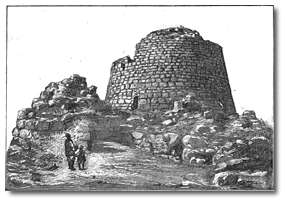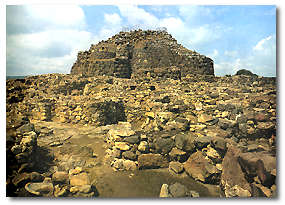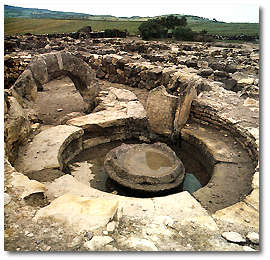At this point it is obvious to ask what
these towers were used for.
The most accepted hypothesis is that these towers had a civil function. They were used for living and
for guarding the surrounding territory. In an emergency, when fights among clans occurred, the
unarmed people who did not take part in these fights, could provisionally shelter inside the very
strong walls of the towers.
|
|

 A linedrawing of a nuraghe dated 1895
A linedrawing of a nuraghe dated 1895 |
The building of the nuragic towers
dates from the Middle Bronze Age (XVI-XV century BC) and finished in Late Bronze Age (at the end
of X century BC), although renovation and rebuilding works were carried out during the Iron Age.
|

 Su Nuraxi - Barumini Su Nuraxi - Barumini |
|
If the nuraghi have captured your interest
and you would like to visit some of the numerous nuraghi scattered in Sardinia, we would like to
suggest the following as well worth visiting. First of all the well-known "Su Nuraxi" which
is in the fertile Marmilla region along the provincial road from Barumini to Tuili.
|
"Su Nuraxi" is a
"polilobato" nuraghe, placed on a plateau 230 meters above the surrounding land. This
nuraghe has a central tower surrounded by a bastion with 4 towers. This bastion is within a large
hexagonal designed barbican which has 7 towers and as many rectilinear barrages connecting them and
two entrances.
Guided visits to "Su Nuraxi" are available every day. In the nearby village of Barumini,
inside the ex convent of the Capuchin Friars, there is an exhibition of some of the artifacts that
were found during the archaeological excavations of "Su Nuraxi".
There is also a multimedia
presentation about "Su Nuraxi".
|
|

 Su nuraxi - Barumini Su nuraxi - Barumini |
|